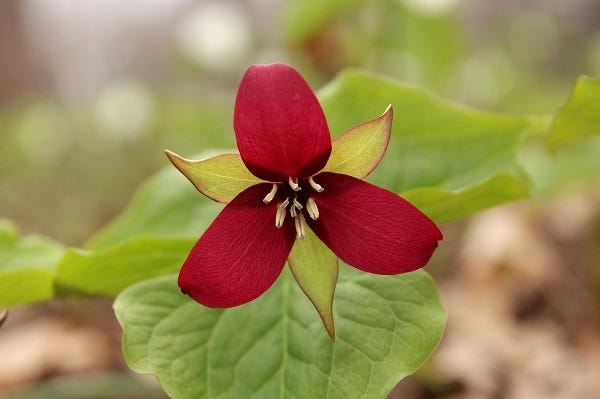
How To Grow Trillium
One of the stars of the spring woodlands across the United States is Trillium. They are called the trinity flower because the plant has three sepals, three leaves, and three petals on the flowers. The flowers come in white, red, yellow and painted, depending upon the species. Trilliums are reliable perennials that slowly spread over time.
When & Where to Plant Trillium
Light: Trillium grow best in a partly-shaded, deciduous woodland habitat and along wet areas in the forest. The further South they grow, the more shade they will require.
Soil: Trillium grow well in fertile, moist, but well-drained soil that's high in organic matter. Trillium can be grown in clay soils, if amended with peat moss and compost.
Spacing: Space the small rhizomes (roots) about 6- to 12-inches apart and about 2- to 4-inches deep. Trilliums naturally multiply into clumps with multiple flowers, but this may take 2 to 4 years after planting.
Timing (planting): Plant trillium rhizomes (roots) in early spring or late summer.

How to Grow Trillium Throughout the Season
Growth Habit: Trilliums grow 12 to 18 inches tall with three leaves and three petals on the flowers. The flowers range in color from white to deep red, depending on the species. They emerge in early spring, and flower for a few weeks depending on the weather. Hot, dry weather will make them go by faster than cool, moist weather. After flowering they set seed and eventually the foliage yellows, allowing the plant to go dormant by midsummer.
Staking: No staking is needed for trillium.
Watering: If you're growing trillium in a forest soil rich in organic matter or amended with leaf mulch, peat moss and compost, little additional watering will be necessary for your trilliums. Once established they're tough plants. Watering right after planting, especially during dry periods, is a good way to help the rhizome get established.
Fertilizing: Amend the soil at planting time with peat moss, leaf mulch (chopped, decaying leaves) or compost. Based on a soil test, adjust the pH to be slightly acidic. Usually the decaying leaves from deciduous trees provide the perfect growing medium for trillium. To enhance the growth in areas where leaves blow away or in a shade garden, each fall add a 1- to 2-inch thick layer of compost or leaf mulch to the planting area.
Trimming & Pruning: Trillium naturally wants to spread by clumping and setting seed. After flowering, let the seeds form. There's no need to cut back the plant in the forest. It will naturally yellow and disappear by midsummer. In the shade garden, if you want a tidier look, wait until the leaves start dying back before cutting the foliage to the ground.
Mulching: Mulch in fall with a 1- to 2-inch thick layer of leaf mulch. Trillium doesn't compete well with other plants, so use the mulch as a means of giving your trillium some room to grow and spread.
Trillium: End of Season Care
Dividing & Transplanting: Trillium don't like to be disturbed and can be hard to divide and transplant successfully, especially from your forest. However, it can be done. In your shade garden, you can dig and divide your own trilliums. Mark where your trillium are growing in the spring.
In late summer, after they go dormant, carefully dig the rhizomes, getting as much of the root system as you can. Gently separate out the individual rhizomes and replant in a location similar to where they were growing well. Keep watered, especially if you have dry conditions.
Digging trilliums you planted in your own forest is harder and less successful because the rhizomes often are growing in among tree roots and other plants. Removing the whole root system without significant damage can be difficult.
Pests/ Disease: Trilliums have few pests and diseases. In the shade garden, watch for slugs and snail damage on the leaves in spring. To reduce damage, remove the mulch away from the plants in spring to reduce hiding places for the slugs.
If possible, avoid killing snails and slugs, because they're helpful in building nitrogen-rich, mineral-laden fertilizer that enhances plant nutrition. To eliminate slugs and snails, you can also use beer traps. Sink a shallow bowl in the soil, so that the rim is positioned at the soil line. Fill it 3/4rds with beer. Each evening the slugs and snails will drown trying to drink the beer. Clean out the bowl each morning. Keep your dogs away from the beer trap because they might like to taste it too.
In the forest, deer may browse on the plants, but usually this damage doesn't kill the plants. If you have a special species you're trying to protect or a new planting, cover it with chicken wire in spring after it emerges.
Trillium: Extra Info
Many trillium species are considered endangered so you should never divide or remove wild trillium from public forest or private lands. Always buy trillium plants and rhizomes from a reputable nursery.

